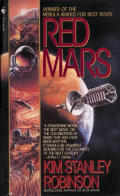
| Series: | Mars #1 |
| Publisher: | Bantam |
| Copyright: | February 1993 |
| Printing: | November 1993 |
| ISBN: | 0-553-56073-5 |
| Format: | Mass market |
| Pages: | 572 |
Red Mars is the first book of Robinson's acclaimed (and very long) trilogy about the colonization and terraforming of Mars. It won a Nebula award, and the remaining two volumes of the series went on to win Hugo awards. Like many of Robinson's books, it's intricately detailed and researched, which is both its strongest feature and its most prominent flaw.
The opening part pulls out an event from much later in the book and shows a murder and political conflict in the first dome-covered town on Mars. This felt like an odd choice. I assume Robinson did that to try to hook readers early, but even after finishing the book, that opening felt strangely disjointed and pulled out of context. After it, Robinson jumps back in time and begins telling the linear story of the settlement of Mars from the perspective of the first hundred, the one hundred colonists sent as the first permanent inhabitants of a robot-constructed settlement. Each part of the book is told from a tight third-person perspective focused on one of the first hundred (with a couple of repeats of perspective).
It's interesting to contrast Red Mars with Heinlein's The Moon Is a Harsh Mistress. The two books are very different in ways that highlight the strengths and weaknesses of both. Heinlein hand-waves through the details of the foundation of his Moon colony and invents imaginary technology like a sentient computer to help drive his plot, while Robinson is relentlessly realistic and tries to only use existing or reasonably extrapolated science. Heinlein also spends little time on the details of the foundation of the colony, whereas that's Robinson's primary plot. However, both books then dive into political turmoil and a revolution of the colony sparked by political manipulation from the bosses on Earth, and in both books the colonists have ideals and desires for a perfect society that they hope to use the colony to fulfill.
This is where Robinson's realistic attitude shines. Heinlein creates a simplistic political and economic situation and an unrealistic unanimity of the colonists. Robinson's political situation looks more like real politics, with multiple points of view even among the first hundred that are defensible on their own terms. Every attempted ideology has its own failures, and the reader frequently is at a loss for who to root for. The revolution, when it happens, is neither as bloodless or as simple as Heinlein's (Robinson even tosses in an amusing rejection of Heinlein's main postulated weaponry), nor is it motivated by simplistic economics. Instead, a combination of lack of local control, uncontrolled immigation by people with a different culture and intentions, and a Malthusian economic situation on Earth for more realistic reasons than Heinlein's drive the tension. Robinson does a great job of making politics a realistically messy combination of competing principles, personalities, and trends that are too large for one person to change.
So far, so good for Red Mars. However, all of this realistic detail comes at the cost of Heinlein's greatest strength: pacing. The Moon Is a Harsh Mistress is fast-moving and never boring, but Red Mars repeatedly bogs down in extended infodumps, tours of Martian geography in sufficient detail to satisfy the most avid Mars lover, and the occasional extended internal emotional monologue. It is, in short, often boring.
This is a shame, since there's more to like about Red Mars than I'd thought there would be. I was expecting a traditional engineer with a wrench story about the technical challenges and engineering. There certainly is a lot of that, but Robinson also creates complex characters, some interesting interpersonal reactions, emotional conflicts, and political and ideological conflicts that drew me into his constructed world. Unfortunately, this is done over so many pages and with such length that the desire to see what happens only barely survives the quantity of prose one has to read through to get there. Robinson is going for an immersive experience, but I just don't care that much about the engineering and geologic details that fascinate his characters.
One's enjoyment of this book will depend, I believe, on how much the immersion works and how much tolerance one has for the slow pace. Red Mars sprawls in a way most often seen in large fantasy novels, and even with all that length, it is very much the first book of a trilogy. None of the major plot themes have been resolved by the end of the book, despite a final part that was one of the strongest of the book. It is, however, an admirable feat of research and realistic construction.
Followed by Green Mars.
Reviewed: 2005-10-26